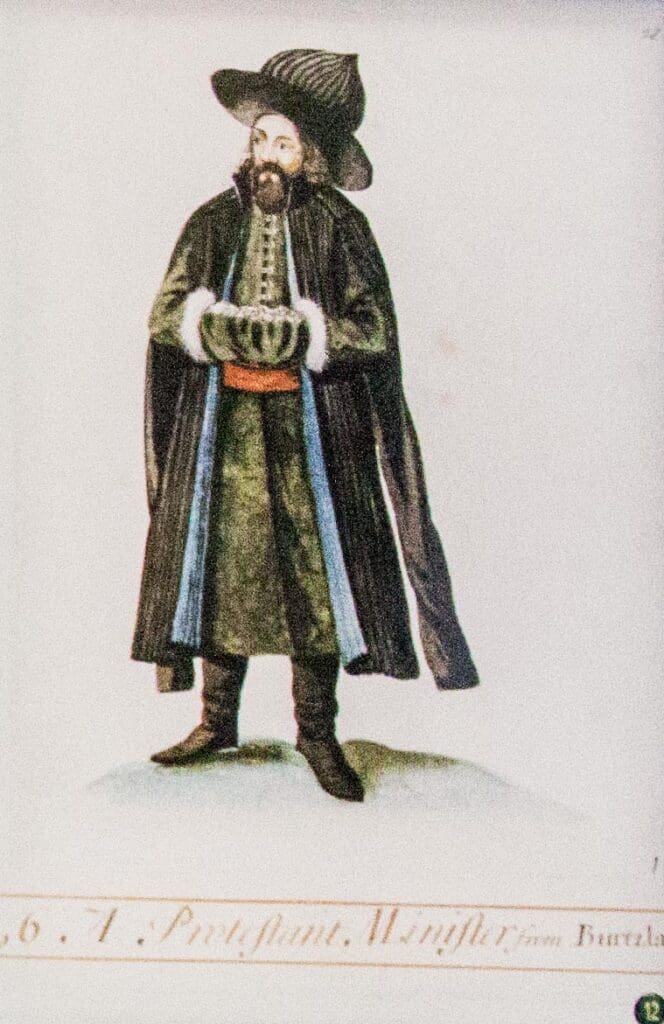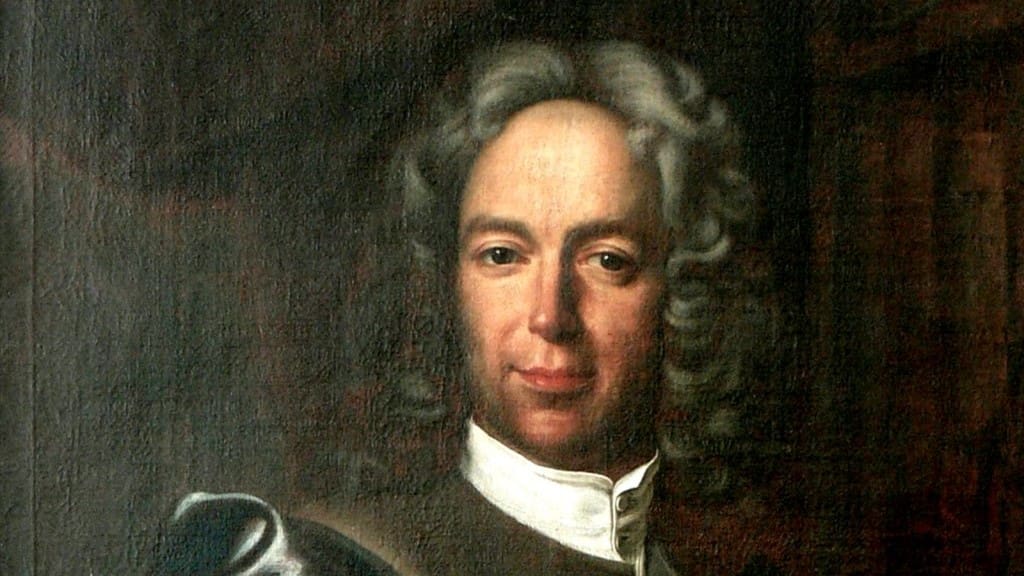Part V: The Clothing of 18th-Century Protestant Ministers*
The 18th century was almost entirely one of constant ‘defensiveness’ as far as the Protestant denominations were concerned, as the attacks of the ‘silent counter-reformation’ had to be fended off somehow. However, in the struggle for survival and existence, the question of ministers’ clothing still remained an issue—the meetings of the Reformed church districts of the time continued to fight against excesses.
A resolution of the General Assembly in Debrecen 1702 banned preachers from wearing beards, and in 1705 the wearing of wigs was also prohibited. This was the downfall of Pál Gyöngyösi Árva, a preacher from Derecske, who had been ordained as a minister in Oxford, where he had also obtained a doctorate in theology, thus had taken the wearing of a wig for granted in his home country as well. Gyöngyösi even voiced his displeasure and, in protest against the decision, edited a lampoon of Bishop Gergő János Kocsi of Debrecen and the leaders of the church district. His action, however, was not without consequences. At the Piskolt Synod in 1706, it was ruled that Gyöngyösi would deserve to have his wig beaten into his head, his English-style garments torn off, and be brought to court. Although this did not happen, the synod suspended him from his post and deprived him of his pastoral ministry. Pál Gyöngyösi Árva then appealed to Prince Francis II Rákóczi, whose intercession led to the annulment of the earlier sentence of the Debrecen Assembly in 1708, but the pastor was still not allowed to remain in the Transtibiscan Reformed Church District. A few years later, in 1711, he was elected preacher in Kassa (today’s Košice, Slovakia), but there he was confronted by the Jesuits and had to leave the city on 5 January 1725 on trumped-up charges.
His passport gives us some interesting information: ‘A man of medium build, neither fat nor thin, with a yellowish-black complexion, short hair, short forehead, medium-thin nose, otherwise full-faced, with black moustache and eyebrows, his right cheek and eyelashes twitching. Hitherto he wore a black woollen toga and a good cloak, emblazoned with a baffle, as was the custom of Helvetic preachers.’**
However, Gyöngyösi insisted on his wig. His journey in hiding finally led him to Poland. At the border, he shed his old clothes, donned a green dolman, and in addition to the wig he always wore, he carried a minister’s hat and his ash-grey woollen mitre, too. Forced to leave his country because of his wig and his faith, he eventually found a new home in Odera-Frankfurt, Germany. He held a professorship in the theology department of the European University Viadrina Frankfurt (Oder) until his death in 1743.
Foreign fashion, as in previous centuries, influenced the clothing of Hungarian preachers as well.
Despite the fall of the Rákóczi War of Independence, Austrian ‘fashion’ also gained ground in the Kingdom of Hungary and Transylvania. In 1714 the Udvarhely (today Odorheiu Secuiesc, Romania) Synod condemned preachers who wore foreign, colourful, worldly robes, shirts with frilly or lace sleeves and bust, silk brocade neckwear, ties, and high-heeled boots. While the synod laid down what was forbidden, it also stated that preachers were required not to wear worn, torn clothes. Even if the clothes are of ordinary ‘once-waulked’ posture, a man of the Church must always preserve the dignity of his office.
The meeting of the Dunamellék Reformed Church District in Tass in 1742 was pleased to note that German fashion was becoming less popular among the pastors who had been abroad and that the Hungarian style of pastoral garments was becoming more widespread. It was also discussed that a moustache should be part of this Hungarian costume, too, so that those who have not done so so far should ‘adorn their lips with a moustache’ if possible.
Nevertheless, even in the middle of the century, the self-esteem of pastors at home was still sometimes hurt by the behaviour of preachers who had been abroad before. Gergely Pál, a preacher from Tiszaszentimre, wrote a long satirical poem about ‘the new academics’, in which he also referred to the clothing of these ministers:
‘The folk admire his Viennese figure,
His slit garments and his curly peruke.
He can raise his hat in a masterly way,
Lord, so they cast their old learned pastor away.’
We can assume that this poem may have played a role in the fact that the minutes of the Transtibiscan Reformed Church District of 1762 also included this question: ‘Does the preacher wear clean and decent clothing, and does he or does he not wear garments befitting a minister?’ Following the question, the by-laws instruct the deacon, at length, on the criteria by which he must judge the costumes of preachers. No other question, even seemingly more important matters, is so meticulously and minutely spelled out.
The main consideration was again what a preacher’s clothing should not contain.
Holy Roman Empress Maria Theresa stopped Protestants from attending foreign universities, and the Sárd Synod of 1783 determined the outfit of Transylvanian pastors studying abroad as follows: ‘Academic priests may wear a German robe, but it must always be black, with all its accessories, and they must not go to any ordinary place in a multicoloured robe called a surtout (Editor’s note: a French- or German-style longer overcoat; Kaputrock in German), like a merchant, at any other time. Either they shall not wear a wig…; for it is much more decent to have neatly arranged hair than to make others laugh with their messed-up wigs.’
In 1787 there was fierce opposition to the clothing of ‘gaudy pastors’ in the Transdanubian region. The minutes of the Tata Reformed Church District read as follows: ‘Sadly experiencing that some preachers, in order to diminish the sacred ministry, do not wear garments befitting their sacred office, but fashionable hats and neckwear, and even go to the cathedra in a coat. Be it known to them that they should remove these clothes and serve in garments fit for godly preachers.’

In addition to the written sources from the 18th century, it is important to look at a historical costume representation, too. There is a painting in the Danube Region Museum in Komárom (Komarno, Slovakia) titled Food of Love. The title is revealing: the painting’s theme is essentially an interpretation of the bread and wine of the Lord’s Supper and gratitude for the 1781 Decree of the Habsburg Emperor Joseph II (which granted freedom of worship and office to certain denominations, including Protestants), expressed in the lines of a poem at the bottom of the painting. On the left side of the painting, there is Joseph II in a hat (since the monarch never crowned himself, he received the nickname ‘the King with the Hat’ in a contemporary mockery poem, which stuck with him), and on the right four priests and ministers representing the religious denominations of Hungary (the Pope, the Patriarch, a Lutheran, and a Reformed preacher) sitting by a round table. The Orthodox and Catholic heads of the Church wear in fancy clothes, while the Lutheran and Reformed pastors are clad in an Austrian outfit, with buckled shoes, and a triangular hat on their heads. The artist’s name is unknown. The artwork was painted after the death of Joseph II in 1790, as we know from the inscription in Latin: ‘tunc mundo cessans vivere vive polo’, meaning ‘now that you have given up life on earth, live in heaven’. The Austrian costume of the Komárom Reformed preacher is understandable since the town was closer to Vienna and more exposed to Austrian influence than, say, a preacher from Debrecen or Transylvania.
As we can see, the clothing of Protestant ministers widely varied during the 18th century. We do not know of any cloak being worn—what is certain is that the clerical robe known and worn today was first donned by Lutheran ministers. According to József Szeberényi, at the Pest Synod in 1791 the Lutheran delegates wore a tightly tailored black cassock, white preaching neck-bands (Editor’s note: the two white bands worn by ministers are sometimes said to symbolize the two tablets of the Ten Commandments given by God to Moses), and a narrow black cloak tied at the neck over the cassock during services.
*This article was largely based on Béla Takács’s book titled A magyar református lelkészek öltözete (The Garments of Hungarian Reformed Church Pastors), Hernád kiadó, Debrecen, 2004.
**This and all the other quotations in the article were translated by Hungarian Conservative.
Read Part I, Part II, Part III, and Part IV:








